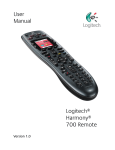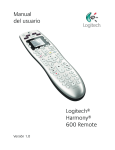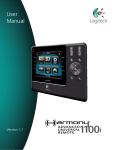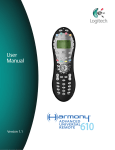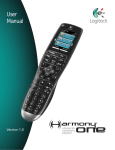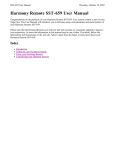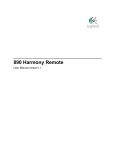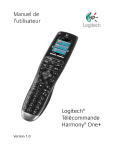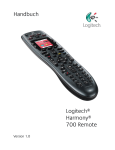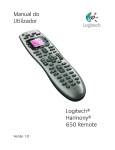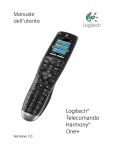Download User Manual Logitech® Harmony® 650 Remote
Transcript
User Manual Logitech® Harmony® 650 Remote Version 1.0 Universal Electronics Exhibit 2034, Page 1 Universal Remote Control v. Universal Electronics, Trial No. IPR2014-01102 © 2010 Logitech Inc. All rights reserved. Logitech's trademarks are either registered trademarks or trademarks of Logitech in the US and other countries. All other trademarks are the property of their respective owners. Universal Electronics Exhibit 2034, Page 2 Universal Remote Control v. Universal Electronics, Trial No. IPR2014-01102 LOGITECH HARMONY 650 USER MANUAL Contents Introduction..........................................................................................................................1 Getting to know your Harmony 650.................................................................................1 How your Harmony 650 works......................................................................................1 Devices, inputs, and Activities.......................................................................................1 The buttons on your Harmony 650...............................................................................2 What’s on the Harmony 650’s screen...........................................................................3 Navigating screen options.............................................................................................3 Using your Harmony 650....................................................................................................4 Selecting an Activity.......................................................................................................4 Using the Remote Assistant...........................................................................................4 Controlling your devices individually............................................................................4 Using your favorite channels.........................................................................................5 Turning off your devices.................................................................................................5 Using the Help button....................................................................................................6 Setting up your Harmony 650 for the first time.............................................................7 Overview.........................................................................................................................7 Creating your user account...........................................................................................8 Connecting your Harmony 650 to your computer......................................................8 Setting up the devices you want to control.................................................................8 Setting up Activities........................................................................................................9 Updating the remote.....................................................................................................9 Determining your inputs..............................................................................................10 Device worksheet.........................................................................................................11 Testing your remote.....................................................................................................12 Changing your setup.........................................................................................................13 Adding and changing Activities...................................................................................13 Adding and changing devices......................................................................................13 Adding a passthrough device to an Activity...............................................................14 Changing buttons for a device or Activity..................................................................15 Teaching commands using your old remote..............................................................15 Universal Electronics Exhibit 2034, Page 3 Universal Remote Control v. Universal Electronics, Trial No. IPR2014-01102 III LOGITECH HARMONY 650 USER MANUAL Setting up favorite channels........................................................................................16 Troubleshooting problems with your Harmony 650....................................................17 Getting help with your Harmony 650.............................................................................18 Using the on-remote help............................................................................................18 Glossary................................................................................................................................19 Product Specification........................................................................................................21 IV Universal Electronics Exhibit 2034, Page 4 Universal Remote Control v. Universal Electronics, Trial No. IPR2014-01102 LOGITECH HARMONY 650 USER MANUAL Introduction The Logitech Harmony 650 remote is your answer to effortless home entertainment. With one-button Activities, you can go from watching TV to watching a DVD or listening to music with a single touch. The guided online setup steps you through the configuration of your Harmony 650, so you’ll soon be ready to sit back and relax! Whether you’re new to Harmony products or you consider yourself an expert, this User Manual provides you with the information you need to get you going. Getting to know your Harmony 650 How your Harmony 650 works The Harmony 650 is an Activity-based infrared (IR) universal remote control. Using Harmony software, you can set up the Harmony 650 to control up to 5 devices. The Harmony 650 delivers powerful Activity-based control using Smart State Technology®. This technology allows the Harmony 650 to keep track of the devices it controls, so it always knows which of your devices are on. Devices, inputs, and Activities To make the most of your Harmony 650, you need to understand the following terms: devices, inputs, and Activities. Devices Devices are the components of your entertainment system. They’re things like your TV, cable box, DVD player, or game console. Inputs Inputs are connections on the back of your devices. Inputs are used to connect your devices to each other. When you want to go from watching TV to watching a DVD or listening to music, you typically need to switch your TV and/or audio receiver to the correct input. For example, if your DVD player is connected to your TV using the HDMI 1 input, then the TV needs to be set to HDMI 1 to watch a DVD. Activities An Activity is something you do with your entertainment system, like watching TV, listening to music, or playing a game. Your Harmony remote automates Activities so that a single button turns on all the necessary devices for each Activity, and switches them to the required inputs. For example, pressing the Watch TV button might turn on your TV, your cable or satellite receiver, and your audio receiver, and switch to the correct video and audio inputs. For information on how to select an Activity, or how to switch between Activities, see Selecting an Activity on page 4. Universal Electronics Exhibit 2034, Page 5 Universal Remote Control v. Universal Electronics, Trial No. IPR2014-01102 1 LOGITECH HARMONY 650 USER MANUAL The buttons on your Harmony 650 The buttons on the Harmony 650 may have different functions or control different devices depending on the Activity or device. For more information, see Changing buttons for a device or Activity on page 15. The All Off button turns off all the devices in the current Activity. The Activity buttons start the appropriate Activity. The More Activities button displays a list of all Activities on the remote screen. The Help button starts the on-remote help. For more information, see Using the Help button on page 6. The arrow buttons below the screen allow you to move through various options on the remote screen. The center button below the remote screen and the side buttons beside the screen let you choose those options. The Menu button opens the menu on the screen of the appropriate device. The Exit button closes the menu or guide on the screen of the device. All off Watch TV Watch a Movie Help Listen to Music More Activities The Info button opens the information section of the guide on the screen of the appropriate device. The Guide button opens the guide on the screen of the appropriate device. The page up and page down arrows help you move quickly through the guide or menu on the screen of the appropriate device. Menu Info Exit Guide The color-coded buttons perform cable, satellite, and teletext functions. The volume button changes the volume for the appropriate device. The directional pad arrows allow you to move through menus or on-screen guides. Vol OK Ch The channel button changes the channels. The mute button mutes the sound. 1 2 3 abc def 4 5 6 ghi jkl mno 7 pqrs clear 8 tuv 0 The previous channel button returns you to the last channel you were on. The playback area includes play, pause, fast forward, rewind, skip and other buttons for your PVR, DVD player, or VCR. 9 wxyz E enter The number pad has the digits 0-9. The enter button enters a selection from the number pad. The clear button clears an entry from the number pad. It is also used to enter the decimal place for HD channel numbers. 2 Universal Electronics Exhibit 2034, Page 6 Universal Remote Control v. Universal Electronics, Trial No. IPR2014-01102 LOGITECH HARMONY 650 USER MANUAL What’s on the Harmony 650’s screen Activities When you press an Activity button – Watch TV, Watch a Movie, or Listen to Music – the Activity starts, and the commands for that Activity appear on the screen. The commands that appear may apply to any of the devices that you use for that Activity. For example, if you’re watching a DVD, your remote screen displays functions and commands for your DVD, your TV, and other devices you use in the Watch a DVD Activity. When you press the More Activities button, the remote screen shows all Activities you have defined. Devices When you are viewing Activities on your remote’s screen, you switch to device mode by pressing the center button below Devices. The Harmony 650’s screen displays a list of your devices. From this screen, you can select a device, then view the commands that are available for that device. Favorite channels If you have favorite channels set up on your Harmony 650, they will appear on the remote’s screen when you start the Watch TV Activity then select Favorites. If the favorite you are looking for doesn’t appear on first page, press the Next button to move to next page of favorites. IR Status Indicator The status indicator flashes in the bottom right corner whenever command is being sent from your Harmony 650. Navigating screen options The buttons surrounding the remote’s screen allow you to navigate the screen options. The arrow buttons help you move through each page of options, while the side buttons allow you to choose an option. The center button lets you switch between Activities and devices, or return to the devices list. The upper right corner of the screen shows the current page number and how many pages there are in total. Universal Electronics Exhibit 2034, Page 7 Universal Remote Control v. Universal Electronics, Trial No. IPR2014-01102 3 LOGITECH HARMONY 650 USER MANUAL Using your Harmony 650 Selecting an Activity You can start an Activity by pressing the appropriate Activity button or by pressing the More Activities button and selecting one of the Activities that appear on the remote’s screen. To switch to a new Activity, press the appropriate Activity button or use the More Activities button to choose another Activity. The Harmony 650 will take care of powering on the required devices, powering off the ones not needed, and changing inputs if necessary. Using the Remote Assistant The Harmony 650’s Remote Assistant appears on the remote screen when you disconnect the remote after syncing, and when you start an Activity. It guides you through the Activity. For example, when you select the Watch TV Activity, the Remote Assistant asks you if the TV is on and if the other devices in the Activity are configured properly. You can temporarily turn off the Remote Assistant by pressing the button beside the Turn off Assistant option on the remote’s screen. The Remote Assistant will reappear after the next sync. Controlling your devices individually In some cases, you may want to control a device individually. You may, for example, want to access a function not included in the current Activity (such as picture-inpicture). When you are in an Activity or on the More Activities screen, pressing the center button shows you a list of your devices. Choose the device you want to control. If necessary, use the arrow buttons to find the page with the desired device. Once you select the device, the Harmony 650 screen shows the commands for that device. Choose the desired command. Once you’ve finished, press the center button to return to Activities mode. If you find yourself regularly switching to device mode to perform a particular function, you should consider adding that function to an Activity. For more information, see Setting up Activities on page 9. 4 Universal Electronics Exhibit 2034, Page 8 Universal Remote Control v. Universal Electronics, Trial No. IPR2014-01102 LOGITECH HARMONY 650 USER MANUAL Using your favorite channels You can set up favorite channels for your TV, or your cable or satellite receiver. For more information, see Setting up favorite channels on page 16. To select a favorite channel: 1. Press the Watch TV button. 2. On your remote’s screen, select the Favorites option. Your favorite channels will appear on the screen. 3. If you have set up more than four favorite channels, they will appear on multiple pages. Use the buttons below the screen to move between pages. 4. To jump to a favorite channel, simply press the button beside the channel number or icon. Turning off your devices Press the All Off button to power off all the devices used in the Activity. You don’t need to turn off devices when switching between Activities. The Harmony 650 ensures the proper devices for the Activity are on or off. Universal Electronics Exhibit 2034, Page 9 Universal Remote Control v. Universal Electronics, Trial No. IPR2014-01102 5 LOGITECH HARMONY 650 USER MANUAL Using the Help button Because obstacles or distance can interfere with the signals the Harmony 650 sends when it starts an Activity (for example, someone walks between your Harmony 650 and the TV when you press Watch TV, or you’re very far away from the system when you start an Activity), your Harmony 650 can become “out of sync” with your devices. To fix the problem, use the Help feature on your remote. 1. On the remote, press the Help button. 2. Answer the questions and follow the instructions on the Harmony 650’s screen. The Harmony 650 re-sends commands to make your remote “in sync” with your devices. 3. To access advanced help features, press and hold the Help button for 5 seconds. Did that fix the problem? No Yes Exit Help If you have used the Help feature to fix the problem several times in the past, you may be asked some questions to help fix the problem permanently. When you’re done with this process, the Harmony 650 will be “in sync” with your devices. Before pressing the Help button, be sure you’ve addressed the cause of the problem (for example, remove any obstacles from the line of sight). 6 Universal Electronics Exhibit 2034, Page 10 Universal Remote Control v. Universal Electronics, Trial No. IPR2014-01102 LOGITECH HARMONY 650 USER MANUAL Setting up your Harmony 650 for the first time Overview You set up your Harmony 650 using a guided online setup process called My Harmony. It asks you a series of questions about your entertainment system as it walks you through the following steps: 1. Creating your user account: The setup walks you through creating a user account on My Harmony. You may also be prompted to download and install software. 2. Connecting your Harmony 650 to your computer: The software ensures that your computer and Harmony 650 are communicating with each other. 3. Setting up the devices you want to control: My Harmony walks you through entering the manufacturer and model numbers of the components of your entertainment system that you can collect using the Device worksheet on page 11. 4. Setting up Activities: My Harmony helps you set up one-button activities that save you the trouble of turning on multiple devices and switching inputs. 5. Syncing the remote: My Harmony transfers your setup information from your computer Guided online setup to the remote. After you set up and sync your Harmony 650 remote, you can change your setup and add favorite channels. For more information, see Changing your setup on page 13. Gathering your device information To simplify the setup process, we recommend you fill out the Device worksheet, so that all the device information is at hand when you need it. Locating manufacturer and model number on your devices Manufacturer names and model numbers are typically found at the front of a device, on a label on the back or side of the device, or in the user manual for that device. Universal Electronics Exhibit 2034, Page 11 Universal Remote Control v. Universal Electronics, Trial No. IPR2014-01102 7 LOGITECH HARMONY 650 USER MANUAL 1. Creating your user account To access My Harmony, open a web browser and go to MyHarmony.com. When you visit MyHarmony.com for the first time, you must create a user account so you can save your settings and return at any time to make changes. From the My Harmony site, follow the online instructions to set up your remote and create your account. Depending on your system, you may be prompted to download and install software. 2. Connecting your Harmony 650 to your computer When asked to do so, connect your Harmony 650 to your computer using the USB cable provided. 1. Connect the smaller end of the cable to the USB port on your remote. 2. Connect the wider end of the USB cable to a USB port on your computer. 3. Once connected, the Harmony 650 will begin communicating with your computer. A Welcome screen will appear when the connection is complete. 3. Setting up the devices you want to control From the Welcome screen, click Next to begin. My Harmony will walk you through the process of setting up devices. You’ll be asked to provide the manufacturer name and model number for all the entertainment devices you want to control with your Harmony 650. You can use the Device worksheet on page 11 to gather the necessary information. For devices with multiple inputs (like TVs and AV receivers), you’ll need to note which devices are connected to them, and with which inputs. Adding new devices at a later time If you want to add additional devices after the initial setup, see Adding and changing devices on page 13. 8 Universal Electronics Exhibit 2034, Page 12 Universal Remote Control v. Universal Electronics, Trial No. IPR2014-01102 LOGITECH HARMONY 650 USER MANUAL 4. Setting up Activities After you have finished identifying your devices, you can start setting up your Activities. An Activity is something you do with your entertainment system, like watching TV, listening to music, or playing a game. Your Harmony remote automates Activities so that a single button turns on all the necessary devices for each Activity, and switches them to the required inputs. For example, pressing the Watch a Movie button might turn on your TV and your DVD player, and switch the TV to the DVD player’s input. 1 --:-- --:-- 2 HDMI 1 3 PLAY 0:00 0:00 0:00 1:10 My Harmony prompts you to set up the Watch TV activity, and allows you to set up other Activities (depending on the devices you have added to your account). If you haven’t added enough devices to support an Activity, you won’t be given an opportunity to add any. When you set up an Activity, you choose the devices that are involved in the Activity, and indicate which devices you use to control which functions. For example, when you set up the Watch TV Activity, you pick the device that changes the channels and the device that controls the volume. If the device has more than one input, My Harmony asks you which input the device uses. If you’re not sure, see Determining your inputs on page 10 for more information. You may also be asked additional questions depending on your entertainment system. 5. Updating the remote When you’re finishing adding Activities, click Sync to transfer your setup information to your Harmony 650. After the remote has been updated, the setup process will prompt you to disconnect the remote from your computer and test your remote on your home entertainment system. For specific details about testing your remote, see Testing your remote on page 12. Universal Electronics Exhibit 2034, Page 13 Universal Remote Control v. Universal Electronics, Trial No. IPR2014-01102 9 LOGITECH HARMONY 650 USER MANUAL Determining your inputs One of the most important steps in creating your Activities for your Harmony 650 is determining which inputs your system uses for each device. If you’re not sure, this section offers some suggestions on how to figure out which inputs your entertainment system uses. Inputs are connections on the back of your devices. Using inputs, you connect your devices to each other. For example, your DVD or cable box may be connected to your TV through an HDMI input. After you know how your devices are connected, you can use the information to create your Activities using My Harmony. Step 1— Turn on all your devices To determine which devices are using which inputs, you should start by turning on all the devices in your entertainment system. If possible, you should start playing something in your DVD player, CD player, VCR, etc. By having all your devices on, it’s easier to see how they’re connected. You can use the Device worksheet on page 11 to keep track of which devices are connected using which inputs. Step 2 — Watch the TV In this step, you must use your TV’s original remote control to switch between inputs. 1. Using your TV’s original remote, press the input button and select each input one-at-atime. 2. For each input, note which device appears to be connected to that input. For example, if you switch to HDMI 1 and see your DVD playing, you know your DVD player is connected to HDMI 1. Step 3 — Listen to the sound You need to complete this step only if you have a separate device (called an audio receiver) that manages the sound for your entertainment system. For example, you may have a home theater system or connect your TV to your stereo so that the sound comes out of your stereo speakers. You must use your audio receiver’s original remote control to switch between inputs. 1. Using your audio receiver’s original remote, press the input button and select each input one-at-a-time. 2. For each input, note which device appears to be connected to that input. For example, if you switch to OPTICAL 1 and hear the sound from your DVD playing, you know your DVD player is connected to OPTICAL 1. 10 Universal Electronics Exhibit 2034, Page 14 Universal Remote Control v. Universal Electronics, Trial No. IPR2014-01102 LOGITECH HARMONY 650 USER MANUAL Device Worksheet As part of setting up your Harmony remote, you will need to enter information about the components in your entertainment system. Fill out this worksheet to use as your guide. List the entertainment components below that you want to control with your new remote. Device Manufacturer Model # Inputs From e.g. TV Sony KDL-42V4100 HDMI 1 Cable box Tip Center How to Find Model Numbers On most entertainment components, the model number is usually found on a label located on the front, back, side, or bottom. TV Cable/Satellite MANUFACTURER DVD MODEL NO: SD-3990-SC Game system 120V AC - 60Hz 13W SN: MC110D00001234 AV Receiver / Home Theater ACME SD-3990-SC What are inputs... and why do I need to know about them? Inputs are how your devices are connected. Your Harmony remote needs to know your inputs so that it can switch them automatically for you when you start an activity. Tips for identifying Manufacturer: • also referred to as “make” or “brand name” • typically on the front of the component • sometimes on the label with the Model Number • examples: Sony®, Phillips®, Denon®, DirecTV®, TiVo®, etc. Tips for identifying Model Number: • also “Model” or “M/N” • usually on a label on the front, back or bottom of the component (see the Tip Center) • model number may be different than model name • also found in the component’s user manual • examples: RC-QN3BK, CT-36XF36C, Explorer 3100, L32 HDTV 10A, etc. • NOT model number on the old remote control • NOT serial number (SN) which is usually much longer If you cannot find the model number on the component itself, the user manual that came with your component should list the manufacturer and model number. Once you have gathered all of your information, take this worksheet to your computer and continue setting up your Harmony remote. © Copyright 2010 Logitech or its licensors. All rights reserved. Universal Electronics Exhibit 2034, Page 15 Universal Remote Control v. Universal Electronics, Trial No. IPR2014-01102 11 LOGITECH HARMONY 650 USER MANUAL Testing your remote Every time you update your Harmony 650, you should test your remote to ensure it’s working the way you expect. This section gives you the information you need to test your remote. It also has some suggestions on what to check while you’re testing your setup. If you run into specific issues while testing your remote, see Troubleshooting problems with your Harmony 650 on page 17 for suggestions and possible fixes for your problems. Testing your Harmony 650 is simple. Just try out the Activities you use most often and use the on-remote help to correct any issues. In some cases, you may need to return to My Harmony to make changes to your remote’s setup to ensure the remote is working the way you want. To begin testing your remote: 1. Disconnect the USB cable from your remote. If this is the first time you’ve updated your remote, the Harmony 650’s tutorial will appear on the remote’s screen. 2. Ensure all the devices in your entertainment system are turned off. 3. If you are viewing the tutorial, follow the instructions displayed on the remote’s screen. 4. Go to your entertainment system and try each of your Activities. For tips on what to look for when starting an Activity, or switching between Activities, see below. 5. If an Activity doesn’t start correctly, press the Help button on the remote and the onremote help will get you back “in sync”. After you finish testing your Activities, be sure to re-test any for which you had to use the Help button. Testing your setup – Starting an Activity Look for these things in particular: • Did all of your devices for that Activity turn on? • Do you hear the correct sound? • If the Activity includes your TV, do you see the correct picture? Testing your setup – Switching between Activities Look for these things in particular: • Are all devices needed for this new Activity on? • Did devices not needed for this Activity turn off? • Do you hear the correct sound? • If the Activity includes your TV, do you see the correct picture? 12 Universal Electronics Exhibit 2034, Page 16 Universal Remote Control v. Universal Electronics, Trial No. IPR2014-01102 LOGITECH HARMONY 650 USER MANUAL Changing your setup Whether you have a new device, or want to add favorite channels, or change the behavior of some buttons, you may need to make changes to your Harmony 650’s setup. In each case, you return to MyHarmony.com, and sign into your account. From the screen that appears, you select the appropriate option and follow the online instructions. Adding and changing Activities When changing an Activity, you can add or remove the devices used, and change any inputs or control options. To add or change Activities: 1. 2. 3. 4. Open a browser and go to MyHarmony.com. Sign into your account. Follow the online instructions to add or change Activities. After you have finished adding or changing Activities, sync your remote. The number of activities you can add depends on the devices you have added to your account. Adding and changing devices To add or change the devices that your Harmony 650 controls: 1. 2. 3. 4. Open a browser and go to MyHarmony.com. Sign into your account. Follow the online instructions to add or change devices. After you have finished adding or changing devices, sync your remote. Note: If you have already set up 5 devices (the maximum number of devices for the Harmony 650), the option for adding devices will not be available. If you delete a device, any Activities using the device will also be deleted. Before deleting the device, modify any Activities that use the device. If you’re replacing a device, add the new one first, then modify your activities to use the new device, then delete the old device. Universal Electronics Exhibit 2034, Page 17 Universal Remote Control v. Universal Electronics, Trial No. IPR2014-01102 13 LOGITECH HARMONY 650 USER MANUAL Adding a passthrough device to an Activity A passthrough device is a device that you add to your system that a signal passes through unaltered. For example, if you use your DVD recorder (or VCR) to record shows from your cable or satellite receiver, you may need to add your DVD recorder as a passthrough device to the Watch TV Activity. In these examples, the DVD recorder and the A/V switch are used as passthrough devices. No picture? No sound? No problem! 14 Universal Electronics Exhibit 2034, Page 18 Universal Remote Control v. Universal Electronics, Trial No. IPR2014-01102 LOGITECH HARMONY 650 USER MANUAL Changing buttons for a device or Activity You may wish to change how your remote buttons work for a particular device or Activity. For example, your TV might have a picture-in-picture feature that you would like to make available on the remote. Using My Harmony, you can quickly and easily add or customize how buttons work for any device or Activity. To change how buttons work in a device or Activity: 1. Open a browser and go to MyHarmony.com. 2. Sign into your account. 3. Follow the online instructions to change or fix buttons. You can change functions for both the fixed buttons on your Harmony 650 remote, and for the options displayed on the remote’s screen. For screen options, you can change both the function and the label used to represent the function on the remote’s screen. Teaching commands using your old remote If there’s a command on your original remote that doesn’t appear on your Harmony remote, or doesn’t work properly, you can use your original remote to teach the command to your Harmony remote. To teach commands to your Harmony remote using your old remote: 1. Go to MyHarmony.com and sign into your account. 2. Follow the online instructions to change the buttons that appear on your remote or the options that are displayed on the remote’s screen. 3. Follow the instructions to add a command that is not included on the command list, or fix one that doesn’t seem to work right. 4. Follow the online instructions to teach the command to your Harmony remote. Universal Electronics Exhibit 2034, Page 19 Universal Remote Control v. Universal Electronics, Trial No. IPR2014-01102 15 LOGITECH HARMONY 650 USER MANUAL When naming a command, Logitech suggests using the following naming conventions to make button assignment easier: • • • • • Don’t use spaces or special characters such as /, & or * in the name. Capitalize the first letter of each word (for example, NextDisc, ModeDigital). Start the command name with its main function (for example, VolumeRearUp, VolumeRearDown, VolumeFrontUp). This helps group related commands. Start commands that select inputs (for example, on a stereo receiver) with the prefix “Input”. Don’t name the input based on what you’ve connected to your device; instead, name it according to how it’s connected (for example, InputHDMI1, InputHDMI2, InputVideo1, InputAux). You can also teach commands from your original remote to the Harmony remote while you are adding a device, while fixing device settings, when adding a missing command, or when fixing a button or screen option. Setting up favorite channels You can set up favorite channels for your TV, or your cable or satellite receiver. If your system has more than one channel changing device, you should set up the favorite channels within your Watch TV Activity for the device you use to change channels. To set up your favorite channels: 1. Open a browser and go to MyHarmony.com. 2. Sign into your account. 3. Follow the online instructions to set up favorite channels. Your favorite channels will appear on the remote’s screen when you start the Watch TV Activity then select Favorites. 16 Universal Electronics Exhibit 2034, Page 20 Universal Remote Control v. Universal Electronics, Trial No. IPR2014-01102 LOGITECH HARMONY 650 USER MANUAL Troubleshooting problems with your Harmony 650 In this section, you’ll find some commonly reported issues and the suggested solutions. These solutions may help you fix problems you’re experiencing. If you still cannot fix the problem, refer to Getting help with your Harmony 650 on page 18. The TV doesn’t go to the right input when starting Activities. • From My Harmony, check your Activity to ensure it is set up to use the correct input for your TV. Next, check that the inputs are in the correct order so the Harmony 650 can cycle through each input. When you try to add a new TV to your account, you get a message informing you that you haven’t entered the correct model number. • The model number for many devices can be found on the front of the device. If it isn’t there, it might be on a label on the back, bottom, or side of the device. The model number shouldn’t be confused with the serial number for the device, or the model number of the device’s remote control, as many different devices by a manufacturer can share the same remote. If you can’t find a device’s model number, you can use the device’s original remote to teach its commands to your Harmony remote. For more information, see Teaching commands using your old remote on page 15. The On Demand command isn’t on the Harmony 650 for the Watch TV Activity. • You can map the command to any unused button on the Harmony 650 or on the remote’s screen. The command is likely in our database, but wasn’t mapped to the Activity. If we’re missing the command, the Harmony 650 can learn it from your original remote. For more information, see Teaching commands using your old remote on page 15. My Harmony is unable to communicate with the Harmony 650. • • • • • • • Ensure that the USB cable is plugged into your computer and into your remote. Ensure that you are not connecting through a USB hub. If you are, connect the cable directly to a computer USB port. Unplug the USB cable from your computer, and plug it in again. Unplug the USB cable from your remote, and plug it in again. Close your browser, start your browser again, and return to My Harmony. Plug the USB cable into a different USB port of your computer. Disable any anti-virus, firewall, or pop-up blocker program. Restart your computer. Universal Electronics Exhibit 2034, Page 21 Universal Remote Control v. Universal Electronics, Trial No. IPR2014-01102 17 LOGITECH HARMONY 650 USER MANUAL Getting help with your Harmony 650 Several support features are available to help you with the setup and customization of your Harmony 650. To access support for your Harmony 650, follow these steps: 1. Go to MyHarmony.com. 2. Sign into your account. 3. Click Support. You’ll be taken you to Logitech’s Support page where the following support options are available: FAQs (Frequently Asked Questions) A searchable list of customer questions with answers provided by Logitech’s support staff and other users. Community forums A message board where Logitech users and moderators discuss product issues and suggest solutions (accessible directly at http://forums.logitech.com). Support staff Contact Logitech Support staff via phone or e-mail. Using the on-remote help When one or more of your devices don’t power on or off, or when they don’t switch inputs correctly, you can use the Help button on the remote for simple troubleshooting. Answer the questions on your Harmony 650 to re-synchronize it with your entertainment system. See Using the Help button on page 6. 18 Universal Electronics Exhibit 2034, Page 22 Universal Remote Control v. Universal Electronics, Trial No. IPR2014-01102 LOGITECH HARMONY 650 USER MANUAL Glossary Activity An Activity is something you do with your entertainment system, like watching TV, listening to music, or playing a game. With your Harmony remote, you can set up an Activity so that a single button on the remote turns on the necessary devices, and switches them to the required inputs. Amplifier A stereo component that outputs to speakers, and increases the gain or level of an audio signal. An amplifier doesn’t typically include a radio. Aspect ratio The ratio of image width to image height. Common ratios are 1.85:1 and 2.35:1. Television screens are usually 1.33:1 (also known as 4:3). HDTV is 1.78:1, or 16:9. A/V switch A device with several audio and video source inputs that sends a selected audio/video source input signal to an output device like speakers or a TV. Device A component in your home entertainment system. DVD recorder (DVR) A standalone unit that resembles and functions very much like a VCR. Like a VCR, DVD recorders all have AV source inputs; as well, it can record TV shows. Input Inputs are the connections on the back of your devices. Using these inputs, you connect your devices to each other. In sync The Harmony 650 knows what state all of your devices are in, such as whether they are on or off and which inputs they were last using. When it loses track of this information, it becomes “out of sync”. Your remote can send commands to your devices to become “in sync” again. IR (Infrared) Type of signal used by most remote controls. Harmony remotes can control devices that use IR for remote control. Mini-system A single unit that is some combination of the functionality of a DVD, VCR, radio, and amplifier. Also known as a home theater or home cinema. Output device A device that produces the sound or picture, for example, a TV or speakers. Passthrough A device that routes video or audio from one device to another device. Universal Electronics Exhibit 2034, Page 23 Universal Remote Control v. Universal Electronics, Trial No. IPR2014-01102 19 LOGITECH HARMONY 650 USER MANUAL Personal Video Recorder (PVR) Contains an internal recorder and player that records and plays video without the use of a removable tape or disc. Typically PVRs can pause, rewind, instantly replay, and play slow-motion for live or recorded TV. Examples of PVR service providers are TiVo, ReplayTV, UltimateTV, and Keen PM. Many cable and satellite providers also provide PVR services and have PVRs included in some of their cable/satellite receivers. Receiver Also referred to as a tuner or a stereo receiver. A receiver can be any component that receives or tunes broadcast signals, or AM/FM radio. Typically refers to the single component that includes a preamplifier, surround processor, multi-channel amplifier, and AM/FM tuner. RF (Radio Frequency) Used by some remote controls to control devices because it doesn’t have the same line-of-sight restrictions as IR (infrared) signals. 20 Universal Electronics Exhibit 2034, Page 24 Universal Remote Control v. Universal Electronics, Trial No. IPR2014-01102 LOGITECH HARMONY 650 USER MANUAL Product Specification LCD size LCD resolution LCD colors Power source Battery type Brands supported Devices supported Maximum # of devices per account Backlit keypad Backlight color IR learning Learning capabilities IR transmitters IR transmission range Memory type Memory capacity Weight Dimensions Warranty Supported platforms 1.5" (diagonal) 128 x 128 pixels 65,000 colors Batteries AA Alkaline 5,000+ 225,000+ 5 Yes Yellow Yes (Up to 200 KHz) Any standard IR device 2 Up to 50 ft Flash 2MB 6 oz (with battery installed) 8.75” x 2.3” x 1.3” 1 year (2 years for Europe) • Microsoft® Windows XP or Vista with Internet Explorer 7+, or Firefox 3+ • Microsoft® Windows 7 with Internet Explorer 8+ or Firefox 3+ • Intel Mac OS® 10.4.8+ with Firefox 3+ or Safari 4 Note: + indicates the specified version of software, or a later version. Universal Electronics Exhibit 2034, Page 25 Universal Remote Control v. Universal Electronics, Trial No. IPR2014-01102 21 © 2010 Logitech Inc. All rights reserved. Logitech's trademarks are either registered trademarks or trademarks of Logitech in the US and other countries. All other trademarks are the property of their respective owners. Universal Electronics Exhibit 2034, Page 26 Universal Remote Control v. Universal Electronics, Trial No. IPR2014-01102


























